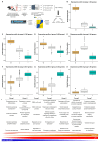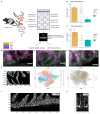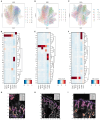Identification and Characterization of Multiple Paneth Cell Types in the Mouse Small Intestine
- PMID: 39273007
- PMCID: PMC11394207
- DOI: 10.3390/cells13171435
Identification and Characterization of Multiple Paneth Cell Types in the Mouse Small Intestine
Abstract
The small intestinal crypts harbor secretory Paneth cells (PCs) which express bactericidal peptides that are crucial for maintaining intestinal homeostasis. Considering the diverse environmental conditions throughout the course of the small intestine, multiple subtypes of PCs are expected to exist. We applied single-cell RNA-sequencing of PCs combined with deep bulk RNA-sequencing on PC populations of different small intestinal locations and discovered several expression-based PC clusters. Some of these are discrete and resemble tuft cell-like PCs, goblet cell (GC)-like PCs, PCs expressing stem cell markers, and atypical PCs. Other clusters are less discrete but appear to be derived from different locations along the intestinal tract and have environment-dictated functions such as food digestion and antimicrobial peptide production. A comprehensive spatial analysis using Resolve Bioscience was conducted, leading to the identification of different PC's transcriptomic identities along the different compartments of the intestine, but not between PCs in the crypts themselves.
Keywords: Paneth cells; single-cell RNA-seq; small intestine.
Conflict of interest statement
The authors declare that they have no conflicts of interest.
Figures






Similar articles
-
Tcf4 regulates secretory cell fate decisions in the small intestine and colon tumors: insights from transcriptomic, histological, and microbiome analyses.Stem Cell Res Ther. 2025 Apr 12;16(1):170. doi: 10.1186/s13287-025-04280-y. Stem Cell Res Ther. 2025. PMID: 40221753 Free PMC article.
-
The enteric microbiota regulates jejunal Paneth cell number and function without impacting intestinal stem cells.Gut Microbes. 2019;10(1):45-58. doi: 10.1080/19490976.2018.1474321. Epub 2018 Jul 11. Gut Microbes. 2019. PMID: 29883265 Free PMC article.
-
[Paneth cells: history of discovery, structural and functional characteristics and the role in the maintenance of homeostasis in the small intestine].Morfologiia. 2014;145(1):67-80. Morfologiia. 2014. PMID: 25051805 Review. Russian.
-
[Identification and classification of lysozyme-expressing cells in the mouse small intestinal crypt and their correlation with the morphology of secretory granules and labeling density of immunogold].Kaibogaku Zasshi. 2009 Sep;84(3):83-91. Kaibogaku Zasshi. 2009. PMID: 19803390 Japanese.
-
Plasticity of Paneth cells and their ability to regulate intestinal stem cells.Stem Cell Res Ther. 2020 Aug 12;11(1):349. doi: 10.1186/s13287-020-01857-7. Stem Cell Res Ther. 2020. PMID: 32787930 Free PMC article. Review.
Cited by
-
Mucosal Immunity: Lessons from the Lower Respiratory and Small Intestinal Epithelia.Biomedicines. 2025 Apr 26;13(5):1052. doi: 10.3390/biomedicines13051052. Biomedicines. 2025. PMID: 40426880 Free PMC article. Review.
-
Detection of chimeric alpha-defensin transcripts and peptides in mouse Paneth cells.Front Immunol. 2025 Feb 6;16:1543059. doi: 10.3389/fimmu.2025.1543059. eCollection 2025. Front Immunol. 2025. PMID: 39981239 Free PMC article.
-
Generation of a new Paneth cell-specific Cre-recombinase transgenic mouse line.Front Immunol. 2025 Jun 25;16:1576995. doi: 10.3389/fimmu.2025.1576995. eCollection 2025. Front Immunol. 2025. PMID: 40636116 Free PMC article.
References
Publication types
MeSH terms
Grants and funding
LinkOut - more resources
Full Text Sources
Molecular Biology Databases
Miscellaneous

